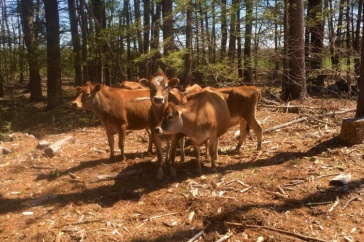
Students who attended forestry summer camp, 1938.
In a state full of trees, a state that is the second most forested in the country, it is fitting that the study of our woods is an integral part of the university’s early history. The recording of those years was written in the 1962 by professor Clark Stevens, who chaired the forestry department from 1938 until 1958. He retired in 1964.
Stevens was one of the first students at UNH to major in forestry, receiving his bachelor’s degree in 1917 from the then-named New Hampshire College of Agriculture and the Mechanic Arts. After serving in the military for two years, Stevens returned to Durham and joined the faculty, teaching classes in tree identification, wildlife management and outdoor education.
Prior to that, from 1890-1895, the only forestry course offered was botany 3. In 1901, forestry 1 and 2 were added followed by forest ecology two years later. In 1911 there were eight classes: forestry principles, silviculture, dendrology, seeding and planting, mensuration, protection, and practice and management, forming what Stevens called the real beginning of the forestry program.
By 1921, there was a forestry club on campus and, under the direction of forestry professor Karl Woodward and using mostly salvaged timber from the land donated by Ben Thompson, they built a cabin in College Woods. The primitive building was used for club activities and by faculty and students until it was toppled in a hurricane in 1923.
It was also in 1921 that several forestry students sought cooking lessons from Miss Isa Greene, head of the home economics department. According to The New Hampshire, the 12 men, “who expected to spend a lifetime in the forests, explained that they want to know how to cook the following articles of food, which they consider essential to the well-being of a forester, to wit: biscuits, doughnuts, and pie.”
During the Great Depression when many students were struggling to stay in school, Woodward let eight forestry students build cabins on his property where they lived for free. The University Archives quotes Howard A. Geddis '38, as saying, "Our cabin (shack) was equipped with wooden bunks, a stove for heat and cooking, a private bath (outhouse) and running water (you ran over to the dairy barn to fill the water bucket). It was fun on a cold morning chopping the ice out of the bucket. Oh yes!! We took showers at the gym.”
In 1923, when the New Hampshire College of Agriculture and the Mechanic Arts became the University of New Hampshire, Stevens proposed that “experience in the woods” should be a component of all majors. He had established a ranger school for disabled veterans shortly after coming to UNH, with a curriculum of half the course work done in a classroom and half done in the woods.
Stevens began a summer camp for UNH forestry students in East Brighton, Vermont, in 1924 and five years later attendance became a requirement. The camps moved to Passaconaway Valley in New Hampshire’s White Mountains in 1929 where they continued until 1964 when the property was sold to the White Mountian National Forest.
In 1935, there were 34 forestry freshmen at UNH. The department moved from Morrill Hall to the top floor of the remodeled Old Cow Barn in 1938 but a fire the following month destroyed all the equipment and supplies. Research data also was lost.
The first issue of the Granite State Forester newsletter was published by forestry club members in 1939 and continued until 1943 when many students were called to serve in the war. Stevens refers to 1943 and 1944 as the “lean years.” Then, in 1947, 25 students attended the summer forestry camp session, up 14 from ten years before.
In September 1954, the forestry department was admitted to the UNH graduate school and in 1962, a two-year course in forestry was launched. At that time, the department had seven staff members, 75 undergraduate students and six graduate students.
Now known as the Department of Natural Resources and the Environment, the program was accredited by the Society of American Foresters in 1959. For more information visit http://www.forestry.unh.edu/.
Originally published by:
UNH Today
Written by Jody Record, UNH Media Relations. Photo courtesy of University Archives.

















































